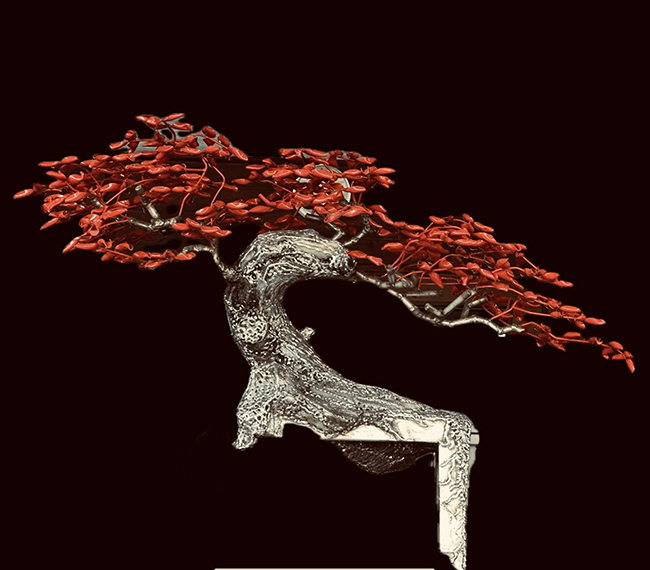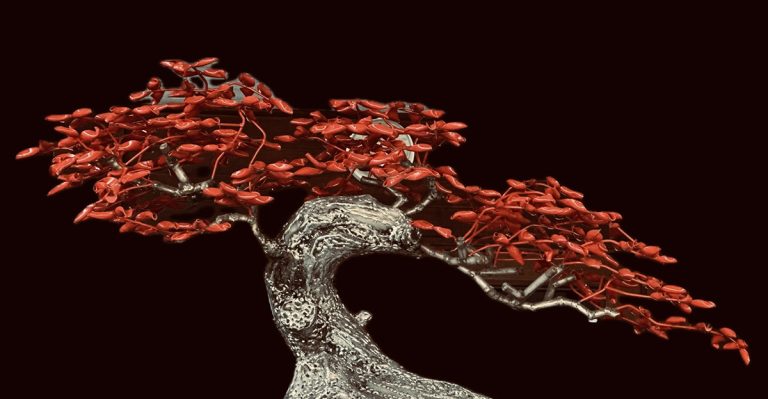DIGEMA, a graduate of the National School of Fine Arts in Paris, is an artist who merges art, knowledge, and technique to create unique pieces that reflect his innovative approach to art. His journey is characterized by constant exploration and a relentless pursuit of singularity in his work. Dijoux’s artistic philosophy is deeply rooted in the concept of interconnectedness and transformation. This is vividly embodied in his sculpture I Am Here, which features a bronze hand releasing butterflies from a flower. The piece draws inspiration from Spinoza’s concept of “Deus sive Natura,” or “God or Nature,” emphasizing the inseparable bond between humanity and the natural world. His art is a dynamic blend of natural forms, philosophical concepts, and technical mastery, always pushing the boundaries of conventional sculpture.

One of DIGEMA’s works is Incandescence. This stainless steel sculpture is a representation of a tree, with symbolic and organic curves that seem to dance against the cold, rigid metal. What makes Incandescencecaptivating is the contrast it embodies. The tree, traditionally a symbol of life and growth, is represented with a material more commonly associated with industrial strength—stainless steel. The welded, heated, and bent form gives the sculpture an impression of movement, as though it were alive despite its metallic structure. The bright red thermolacquered leaves provide a vivid contrast to the coldness of the steel. The tension between the living energy suggested by the organic curves and the harsh, unyielding nature of the metal creates a powerful visual experience. This tension also reflects the broader relationship between humanity and nature, hinting at how we shape and are shaped by the world around us.

Another piece that digs deep into philosophical and human themes is Duality. This bronze sculpture captures the essence of opposing forces, specifically those of masculinity and femininity. Here, DIGEMA uses the inner and outer branches of the sculpture to symbolize these contrasting energies. The broken circle at the center of the piece is a significant element, suggesting disruption or incompleteness, while at the same time, flowers emerge from it, representing nature’s ability to overcome constraints. The flowers act as a metaphor for unity and growth, born out of conflict or opposition. In Duality, DIGEMA masterfully combines the elements of strength and fragility, with the branches and blossoms representing a balance between the eternal masculine and the fleeting feminine. This intimate dialogue between these forces is a recurring theme in much of his work, offering viewers a chance to reflect on the intricate balance of life’s opposing energies.

Emerging Roots, a bronze sculpture inspired by Heidegger, takes a more introspective and existential approach. The piece is created using a molding technique, bringing to life a concept that examines human existence and the constraints we face. DIGEMA draws from Heidegger’s idea of “thrownness,” the notion that humans are thrown into existence and must navigate the societal and material constraints that come with it. In this sculpture, rooted feet symbolize this confinement—humans, much like plants, are rooted in their environment, bound by the limitations of society and circumstance. However, the sculpture also suggests a sense of emergence, a striving to break free from these restrictions. This duality between confinement and freedom is central to the piece, echoing the human quest for self-determination and transcendence. The emerging element in the sculpture symbolizes hope, resilience, and the possibility of rising above material and existential limitations.
DIGEMA’s work is a testament to his deep philosophical engagement and technical skill. Each of his sculptures explores complex themes of nature, existence, and duality, inviting the viewer into a dialogue that transcends the mere visual experience. Through his unique blend of material and concept, he challenges us to consider our place within the broader natural and philosophical order. His work is not just about creating objects of beauty; it’s about pushing boundaries, asking questions, and encouraging reflection.
The piece I Am Here, with its bronze hand and butterflies, showcases DIGEMA’s ability to intertwine the physical and the metaphysical. The connection between humanity and nature is a theme that runs through all of his work, whether it’s through the organic curves of Incandescence, the symbolic dialogue of Duality, or the existential exploration in Emerging Roots. His art is about transformation—both the transformation of materials and the transformation of ideas. It’s this constant state of change and progression that makes DIGEMA’s work feel so alive, even when it’s constructed from cold, unyielding materials like bronze and steel.
In DIGEMA’s world, art is not static; it’s a living, breathing exploration of what it means to exist, to be human, and to be part of something much larger than ourselves. His sculptures speak to this interconnectedness, and in doing so, they invite us to consider our own relationship with the world and with ourselves.

